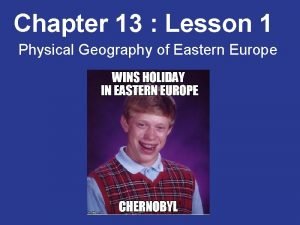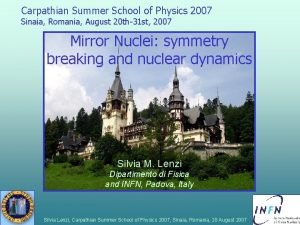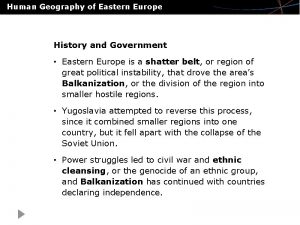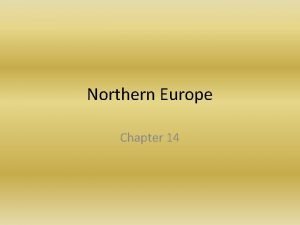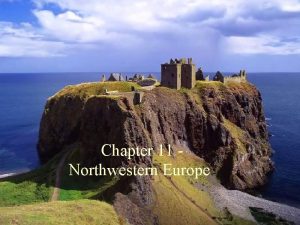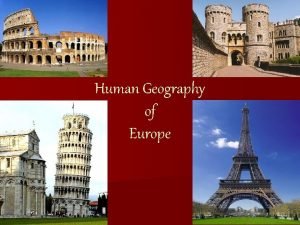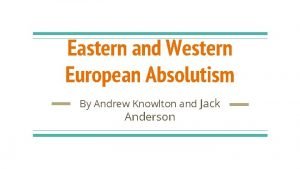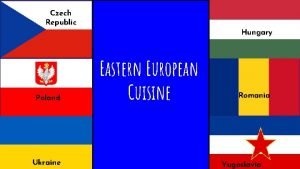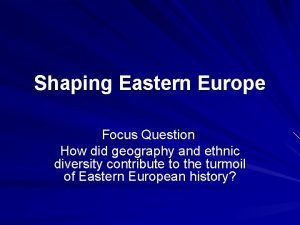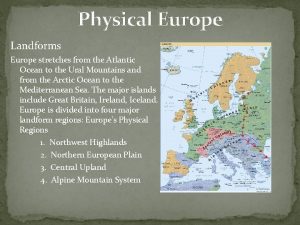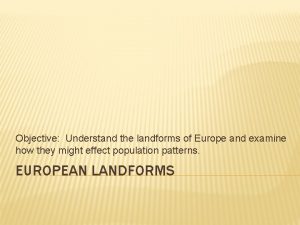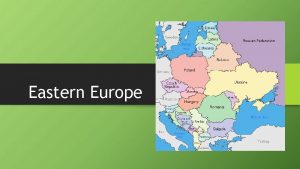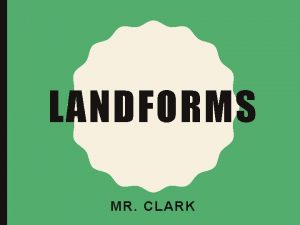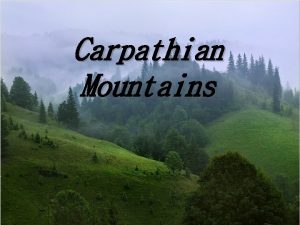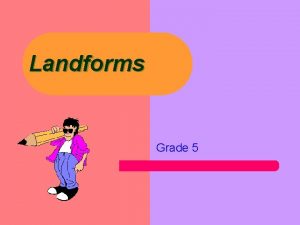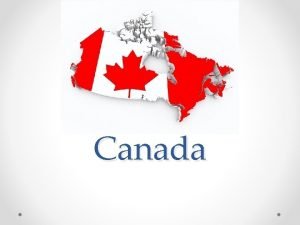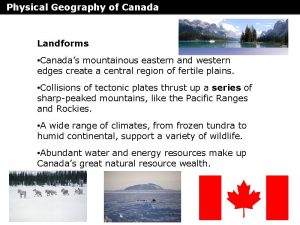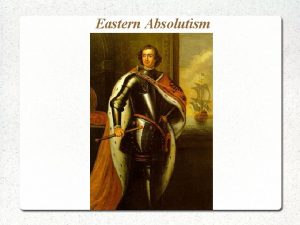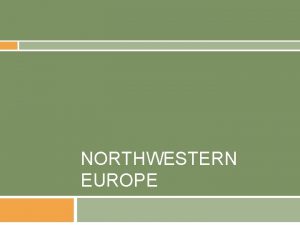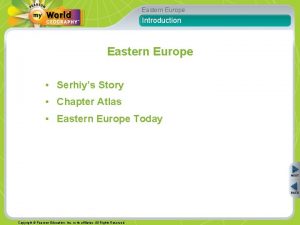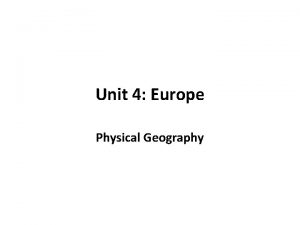CHAPTER 13 EASTERN EUROPE PHYSICAL GEOGRAPHY LANDFORMS Carpathian

















- Slides: 17

CHAPTER 13: EASTERN EUROPE

PHYSICAL GEOGRAPHY

LANDFORMS • Carpathian Mountains in Slovakia Balkan Mountains in Bulgaria • Dinaric Alps along Adriatic Sea • All are eastern extensions of the Swiss Alps

LANDFORMS • Adriatic coast exhibits KARST topography: limestone bedrock with rocky ground, caves, sinkholes, underground rivers, and absence of surface streams and lakes • Due to the soluble limestone

LANDFORMS • Plains dominate the north (Poland Baltic states) • Part of the Northern European Plain • Hungarian Plain: runs through Hungary, Croatia, Serbia, and western Romania

RIVERS • Danube River: 2 nd longest in Europe; begins in the Black Forest (Germany) and empties into the Black Sea • Vistula River: largest in Poland; empties into Baltic Sea • Oder River: begins in Czech Rep. ; forms part of boundary btwn Poland Germany

SEAS • Black Sea: eastern coast of Balkan Peninsula • Baltic Sea: north; btwn mainland Europe and Scandinavian Peninsula • Adriatic Sea: btwn Balkan Penin. and Italian Penin

NATURAL RESOURCES • Natural gas, coal, and oil in Carpathian Mts • Poland: coal, nat gas, iron, zinc, lead, copper, silver, amber • Bauxite is abundant (used to make aluminum)

SECTION 2: HUMAN GEOGRAPHY

SHATTER BELT • Nickname for E. Europe • Due to constant political and territorial fracturing along ethnic lines • More likely to engage in interstate wars

EARLY PEOPLES • Early people were called Slavs • Migrated from Asia • Balkan peninsula mountains protected them from invaders • 106 A. D. : Romans conquer the area and name it Romania

CONFLICT • Balkans has long been unstable • After WWI (break up of Ottoman Empire), people left with no formal country • Yugoslavia is created, combining numerous different ethnicities in one area • BALKANIZATION: division of a region into smaller regions • Yugoslavia creation was the opposite

SOVIET UNION • After WWII: Eastern Europe falls under control of the communist Soviet Union • Brings about Cold War • E. Euro was a “buffer zone” for the Soviets • Provided military protection and led to different types of political, social, and economic changes

THE NEW ERA • 1950 s-1980 s: periodic revolts against communists • 1989: Berlin Wall falls, marking the end of Soviet control • By 1991, nationalist protests led to the secession of Slovenia, Croatia, Bosnia. Herzegovina, and Macedonia from Yugoslavia

NEW ERA CONTINUED • Serbia and Montenegro remained in Yugoslavia • Led to ethnic tensions, resulting in civil war • Serbia, under Slobodan Milosevic began practicing… • ETHNIC CLEANSING: the expelling from a country or genocide of an ethnic group • Targeting Bosnia Croats and Bosnian Muslims

NEW ERA CONTINUED • International peace keeping force responds • Milosevic overthrown • 2006: Montenegro declares independence from Serbia • 2008: Kosovo independence • Yugoslavia now divided into 8 countries

ECONOMICS • Industrialized under Soviet rule • Still fairly agrarian • Olives, citrus fruits, dates, grapes • Center for low-cost manufacturing of electronics
 Chapter 13 lesson 1 physical geography of eastern europe
Chapter 13 lesson 1 physical geography of eastern europe Eastern europe landforms
Eastern europe landforms Carpathian summer school of physics
Carpathian summer school of physics Human geography of eastern europe
Human geography of eastern europe Eastern woodlands landforms
Eastern woodlands landforms Physical geography
Physical geography Glaciation left hundreds of thousands of
Glaciation left hundreds of thousands of What countries in northwestern europe
What countries in northwestern europe Igcse history chapter 6
Igcse history chapter 6 What is considered eastern europe
What is considered eastern europe Differences between western and eastern europe
Differences between western and eastern europe Eastern european cuisine
Eastern european cuisine Offshoring eastern europe
Offshoring eastern europe How did its rivers affect eastern europe
How did its rivers affect eastern europe European landforms
European landforms Northern europe landforms
Northern europe landforms Middle east map
Middle east map Vocabulary activity 12 cultural geography of europe
Vocabulary activity 12 cultural geography of europe
